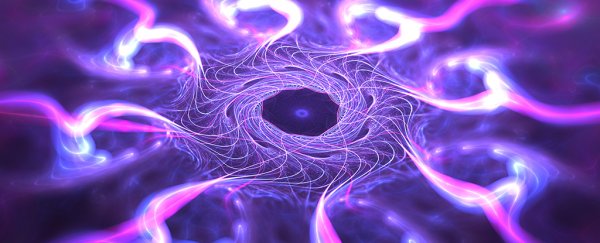Photons - those fundamental particles of light - have a slew of interesting properties, including the fact they don't tend to crash into one another. That hasn't stopped physicists from trying, though.
University of Chicago physicists have now come up with a new, highly flexible way to make photons behave more like the particles that make up matter. It might not give us lightsabers, but making photons collide could still lead to some fantastic technologies.
The trick to getting particles of light - which have no mass - to acknowledge one another's existence is to have them meet in the quiet confines of an atom, and combine their properties with those of an electron.
Researchers have been studying these interactions in the lab for several years now. The electron-photon partnerships form a kind of 'hybrid' quasiparticle called a polariton. Or, if you prefer your science to come with a touch of whimsy, magic dust.
Whatever you want to call them, having light-like qualities allows polaritons to move quickly through space, while their atomic meeting room determines how they interact, giving them the best of both worlds.
Low mass, photon-like particles have huge potential in computing and encrypted communication, so physicists are keen to get a better grip on controlling them.
"But we were running into a problem because the photons only interact with atoms whose electronic orbitals are at very particular energies," says University of Chicago physicist Logan Clark.
Being constrained to only using electrons at a handful energies is about as useful as a keyboard of vowels. It helps to have a few more interactions up your sleeve if you want them to have a wide range of applications.
Clark was already looking at ways of manipulating the complexities of atomic energy levels by making use of a quirk of quantum physics that splits electron orbitals into copies when given the right kind of shake.
"We had always viewed the copies as a side effect rather than the goal," says Clark.
"But this time, we shook our electrons with the specific intent of making the copies."
Getting a particle to jiggle in just the right quantum fashion requires the application of Floquet engineering, which has its roots in a history of tinkering with electromagnetic fields in a carefully timed fashion.
Clark and his team used a laser to nudge electrons in an excited rubidium atom, making them buzz in a way that effectively changed the atom's colour spectrum.
Usually atoms don't like to change their stripes. The hydrogen emits the same spectrum of colour no matter where it is in the Universe, for example; a feature that helps us identify it and other elements far away in space.
But by plucking the orbitals of rubidium's electrons in the right way, the physicists could change their orbitals. Tuning the laser just right then gave them a shake that produced a number of new energy levels from each orbital.
It was then a matter of combining photons with the cloned electron orbitals operating at multiple levels, creating a variation on the quasiparticle the researchers have dubbed a Floquet polariton.
Like the more common variety, these hybrids have properties of light with a small amount of mass provided by its interaction with the electron.
Unlike other polaritons, they exist in a space that can be better customised that can be controlled by simply modulating the frequency of their surroundings.
"Floquet polaritons are full of surprises; we're still continuing to understand them better," says Clark.
"Our next order of business, though, will be to use these colliding photons to make topological 'fluids' of light. It is a tremendously exciting time."
Using Floquet engineering to match the rainbow of light from various sources will almost certainly help quantum technologies advance, not to mention providing new ways to study interactions of light and matter.
Polaritons might not be the solid beams of light of science fiction, but they just might brighten the future anyway.
This research was published in Nature Letters.
